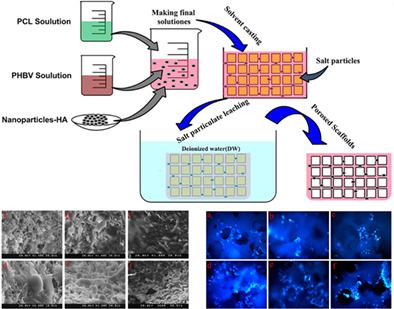当前位置:
X-MOL 学术
›
J. Biomed. Mater. Res. Part A
›
论文详情
Our official English website, www.x-mol.net, welcomes your
feedback! (Note: you will need to create a separate account there.)
Design and fabrication of bone tissue scaffolds based on PCL/PHBV containing hydroxyapatite nanoparticles: dual‐leaching technique
Journal of Biomedical Materials Research Part A ( IF 3.9 ) Pub Date : 2020-08-17 , DOI: 10.1002/jbm.a.37087 Amir Nahanmoghadam 1 , Maryam Asemani 1 , Vahabodin Goodarzi 2 , Somayeh Ebrahimi-Barough 3
Journal of Biomedical Materials Research Part A ( IF 3.9 ) Pub Date : 2020-08-17 , DOI: 10.1002/jbm.a.37087 Amir Nahanmoghadam 1 , Maryam Asemani 1 , Vahabodin Goodarzi 2 , Somayeh Ebrahimi-Barough 3
Affiliation

|
Scaffolds are the important part of the tissue‐engineering field that are made from different biomaterials using various techniques. In this study, new scaffold based on polycaprolactone (PCL) and poly (hydroxybutyrate‐co‐hydroxyvalerate) (PHBV) containing hydroxyapatite nanopraticles (n‐HA) were fabricated using the dual‐leaching technique (DLT). Morphology, porosity, degradation rate, Fourier transfer infrared ray (FTIR) spectra, surface, and mechanical properties as well as capacity of cell binding and cell proliferation on the constructed scaffolds were evaluated. FTIR analysis showed that n‐HA particles have some interest interactions with polymeric chains. The best 3D‐structure was seen in PCL70PHBV30 scaffold using the scanning electron microscopy (SEM) and its structure improved in the presence of 3, 5 wt% of n‐HA. Results of energy dispersive x‐ray analysis (EDXA, map of Ca) showed that the nanoparticles have the uniform distribution within the fabricated scaffolds. Porosity analysis showed that the particulate salt leaching technique is a successful approach to building a 3D structure. Increasing of PHBV content and n‐HA up to 3 and 5 wt% in the PCL matrix led to increase porosity in all samples. Mechanical properties analysis showed that values of compression modulus and strength are decreased with addition of PHBV and HA nanoparticles. These results were directly in line with the results of morphology and porosity. Cell culture experiments demonstrated that the PCL/PHBV/nHA nanocomposite scaffold has a better tendency of proliferation to cells than that of the pure PCL/PHBV scaffold. All of these results suggest promising potentials of the developed PCL/PHBV/nHA scaffolds in this study desire for bone tissue engineering.
中文翻译:

基于 PCL/PHBV 羟基磷灰石纳米颗粒的骨组织支架的设计和制造:双重浸出技术
支架是组织工程领域的重要组成部分,由不同的生物材料使用各种技术制成。在这项研究中,使用双浸出技术(DLT)制造了基于聚己内酯(PCL)和含有羟基磷灰石纳米颗粒(n-HA)的聚(羟基丁酸酯-共羟基戊酸酯)(PHBV)的新型支架。对形态、孔隙率、降解率、傅里叶转移红外线 (FTIR) 光谱、表面和机械性能以及构建的支架上的细胞结合和细胞增殖能力进行了评估。FTIR 分析表明 n-HA 颗粒与聚合物链有一些有趣的相互作用。使用扫描电子显微镜 (SEM) 在 PCL70PHBV30 支架中观察到最好的 3D 结构,其结构在 3, 5 wt% 的 n-HA 存在下得到改善。能量色散 X 射线分析(EDXA,Ca 图)的结果表明,纳米颗粒在制造的支架内具有均匀分布。孔隙率分析表明,颗粒盐浸出技术是构建 3D 结构的成功方法。PCL 基质中 PHBV 含量和 n-HA 含量增加至 3% 和 5% 会导致所有样品的孔隙率增加。力学性能分析表明,随着PHBV和HA纳米颗粒的加入,压缩模量和强度值降低。这些结果与形态和孔隙率的结果直接一致。细胞培养实验表明,PCL/PHBV/nHA纳米复合支架比纯PCL/PHBV支架具有更好的细胞增殖趋势。
更新日期:2020-08-17
中文翻译:

基于 PCL/PHBV 羟基磷灰石纳米颗粒的骨组织支架的设计和制造:双重浸出技术
支架是组织工程领域的重要组成部分,由不同的生物材料使用各种技术制成。在这项研究中,使用双浸出技术(DLT)制造了基于聚己内酯(PCL)和含有羟基磷灰石纳米颗粒(n-HA)的聚(羟基丁酸酯-共羟基戊酸酯)(PHBV)的新型支架。对形态、孔隙率、降解率、傅里叶转移红外线 (FTIR) 光谱、表面和机械性能以及构建的支架上的细胞结合和细胞增殖能力进行了评估。FTIR 分析表明 n-HA 颗粒与聚合物链有一些有趣的相互作用。使用扫描电子显微镜 (SEM) 在 PCL70PHBV30 支架中观察到最好的 3D 结构,其结构在 3, 5 wt% 的 n-HA 存在下得到改善。能量色散 X 射线分析(EDXA,Ca 图)的结果表明,纳米颗粒在制造的支架内具有均匀分布。孔隙率分析表明,颗粒盐浸出技术是构建 3D 结构的成功方法。PCL 基质中 PHBV 含量和 n-HA 含量增加至 3% 和 5% 会导致所有样品的孔隙率增加。力学性能分析表明,随着PHBV和HA纳米颗粒的加入,压缩模量和强度值降低。这些结果与形态和孔隙率的结果直接一致。细胞培养实验表明,PCL/PHBV/nHA纳米复合支架比纯PCL/PHBV支架具有更好的细胞增殖趋势。











































 京公网安备 11010802027423号
京公网安备 11010802027423号